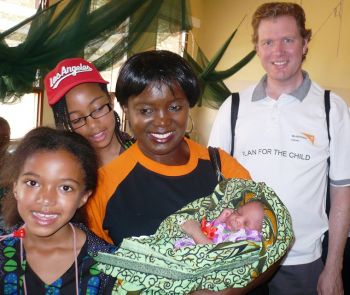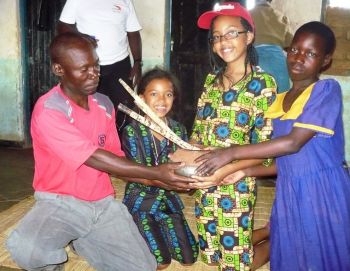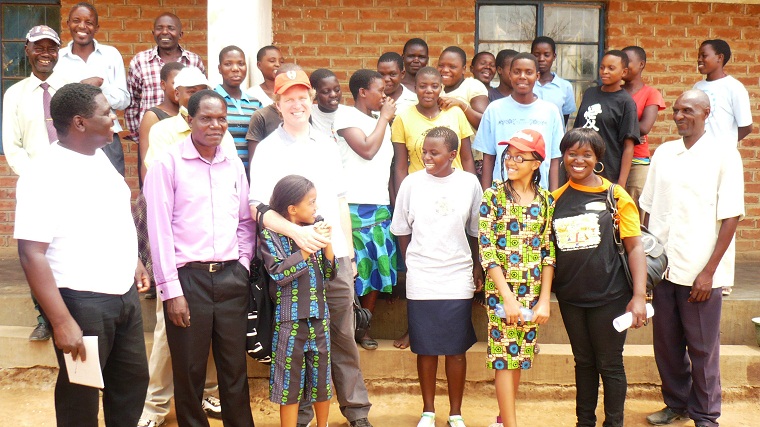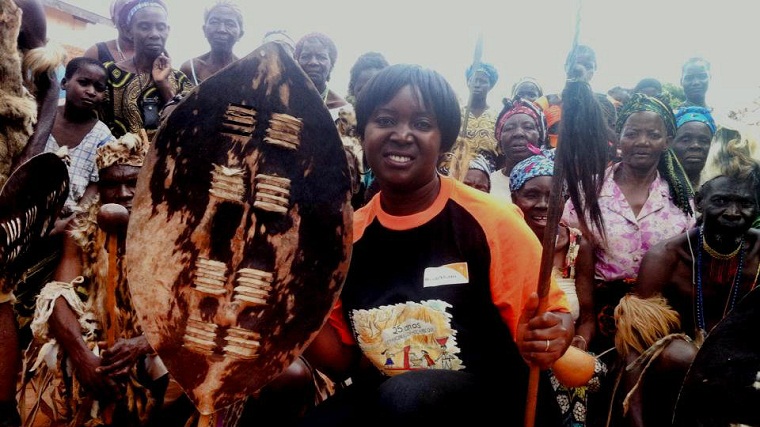Visiting Kettie in Malawi
12-year-old Davina shares her story of meeting her familiy's sponsored child in Malawi.
At around 8 am, we set off from our hotel. Two guys from World Vision picked us up in a jeep sort of car (except it had a roof) which looked cool on the inside because the seats were down the sides of the car so we could face each other.
There was Mum, Damaris, my little sister who is 8, Dad and me in the back and the World Vision officers were in front. In the jeep, Mum and Dad signed some forms while Damaris and I played games and looked outside. We stopped several times to do some shopping. We bought Kettie, our sponsored child and her family some groceries like soap and sugar and stuff like that and Kettie some clothes in a big size so she could grow into them. We had also packed some stationery and school stuff for her too.
When we finally got to the World Vision office after a two-hour-drive, we didn’t go straight to Kettie’s village but to a building where we were told about what the plan was for the day and what had changed because of our sponsorship.
They had bought cattle for dairy, built a maternity wing at the hospital, built a girls’ hostel at the local secondary school and finished building Kettie’s school. We were going to visit the maternity wing, then the girls’ hostel and finally we’d go to Kettie’s village for lunch.
Naming babies
 As the hospital was just nearby to the World Vision office, we walked there. Outside, there were lots of people waiting to be seen. First we met the lady in charge of the maternity wing who showed us around. We saw where she counselled people who come for HIV testing, the delivery room where the babies are born and even the room where the mums were looking after their newborns. There were eight beds in a row and in seven of them there was a lady and a baby who was born not more than a day before.
As the hospital was just nearby to the World Vision office, we walked there. Outside, there were lots of people waiting to be seen. First we met the lady in charge of the maternity wing who showed us around. We saw where she counselled people who come for HIV testing, the delivery room where the babies are born and even the room where the mums were looking after their newborns. There were eight beds in a row and in seven of them there was a lady and a baby who was born not more than a day before.
The day before had been Mother’s Day in Malawi so those children were pretty special. We got to hold some of them and were allowed to take pictures.
Some of the people who were accompanying us wanted us to name some of the babies but we refused because we thought that that was their family’s job and that we shouldn’t name somebody else’s child. The babies were really cute though.
Next we walked to the secondary school, which wasn’t very far away, to see the girls’ hostel. First we looked at the notice board and found that Kettie’s brother went there. We also saw that they put the exam results on the notice board where everyone could see. We were told that this made the students push themselves so that they wouldn’t be embarrassed.
We met the headmaster who answered our questions about the school. He showed us where the hostel was too. There were bunk beds, four per room usually and there were about four rooms. There were no mosquito nets and the girls had to provide their own food.
There was no electricity. However, the girls seemed pretty happy. We had a conversation with them. It seemed that a lot of the girls were repeating or had repeated classes. I think that they were doing better though now that the hostel was there and they didn’t have any other distractions like babysitting family and chores.
Meeting Kettie
 We went back to the jeep and drove to Kettie’s village. We stopped at her school and met up with her there.
We went back to the jeep and drove to Kettie’s village. We stopped at her school and met up with her there.
Even though there were lots of kids, I recognised her from the photos we had. She was wearing her school uniform.
Then we went into her school building and after greetings and introductions, we listened to a speech from her teacher about what had been done with the money from us.
Afterwards we asked him how Kettie was doing and he said that she was always top of the class.
We then drove to Kettie’s house which was a bit far from the school but Kettie said she takes a shortcut when walking there.
When we arrived at Kettie’s house, there was a whole troop of traditional dancers, dancing and singing, which Kettie said that she could do as well. They led us right up to the front door and then showed us to our seats in a straw shelter. They did traditional dancing right up till lunch time. Mum and Dad even had a go! I didn’t though, I stayed and taught Kettie how to use the video on my mum’s phone and she ended up taking some pretty good ones.
At lunch time, we went into Kettie’s living room and had lunch. There was nsima (a hard maize porridge), chips, rice, beef and chicken. It tasted really good. I ate a bit of everything. After lunch, we went outside and watched some more traditional dancing. I tried to do the drums. Two masked men came and danced and then went.
We were also shown the small calf that Kettie’s family had been given as part of a livestock project. The community manages the project and when a cow gives birth to a calf, the calf is passed on to a neighbouring family. That family does the same when the cow they received has a calf.
Kettie and I wanted longer to chat and have some more fun together but about half an hour later it was time to say our goodbyes and travel back to our hotel for the night.
Reflections
I asked the rest of my family what they thought of the visit and here’s what they said:
Dad: It was good to visit the community we support through World Vision’s child sponsorship programme. As someone who has worked in international development for more than 20 years, it provided me with an opportunity to see a child focused community development programme through the eyes of my two daughters and Kettie, our sponsored child.
My children and Kettie would have liked to have had more time to chat and play – incr edible to see how children from across cultures can connect with each other. They also reminded me that as we organise our programmes, we need to do better at considering the priorities children have.
edible to see how children from across cultures can connect with each other. They also reminded me that as we organise our programmes, we need to do better at considering the priorities children have.
The children valued the connection and relationship that sponsorship has given them as much as the structures the funding had built.
Damaris: My favourite parts about visiting Kettie and her family were when we shared our gifts and my other favourite part was when they did the cultural dancing.
When we went to the clinic the babies were very cute and it was a surprise for me that some of the babies were born on mother’s day.
Mum: My highlight was Kettie’s smile when she saw us arriving and the hug she gave me as we greeted. Of course seeing all the new born babies at the maternity wing just the day after Malawi had celebrated Mother’s day was wonderful. Great that mum’s in the area where Ketties lives no longer have to travel as far to deliver their babies.

Thanks to Davina and the rest of the family for sharing their special experience with us. If you would like to comment on their blog or ask them questions, you can do so on our Facebook page.
